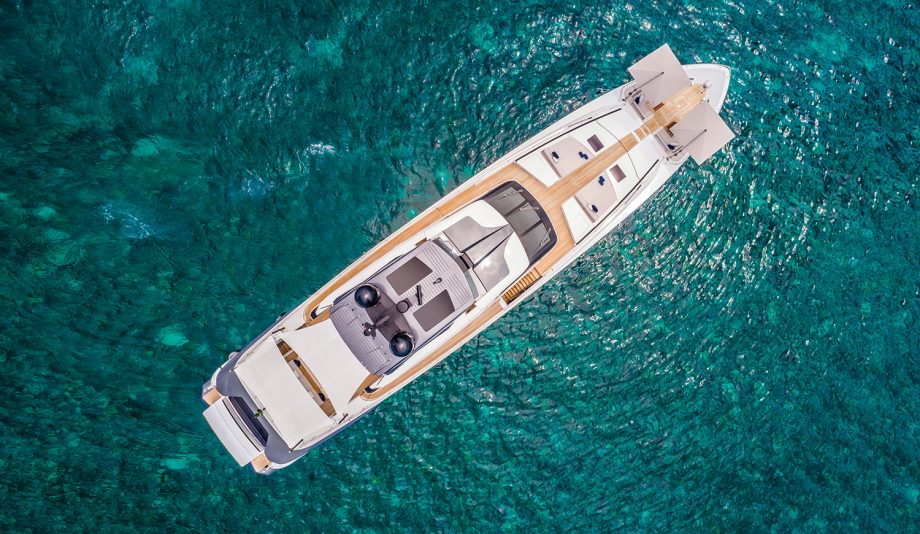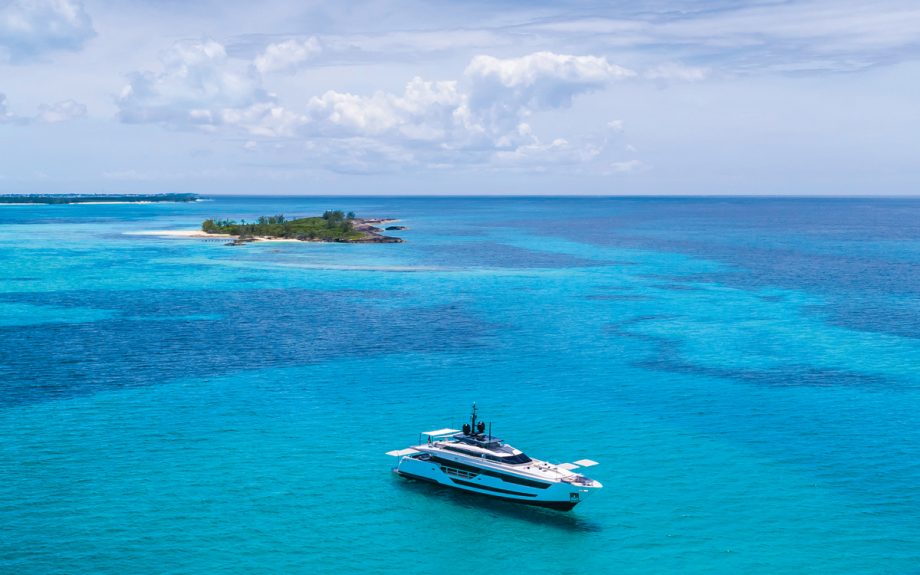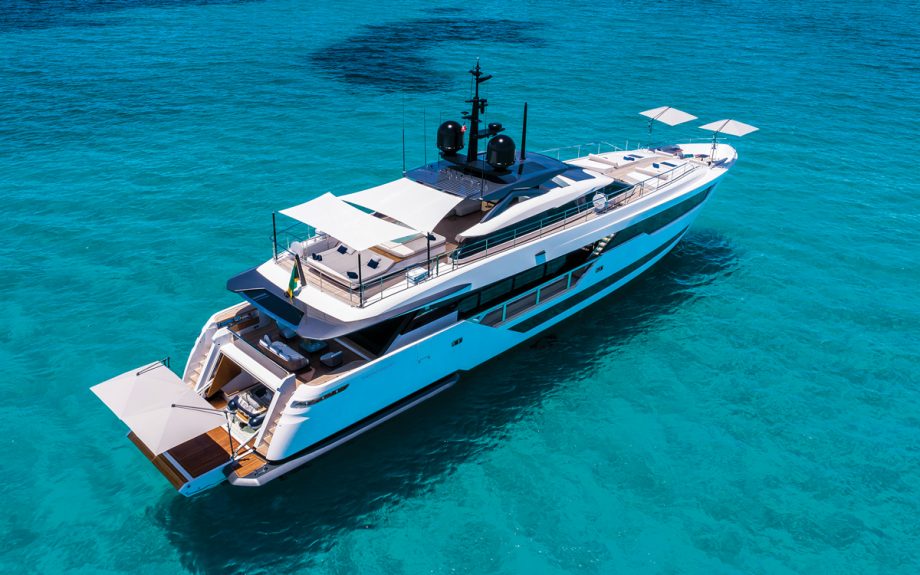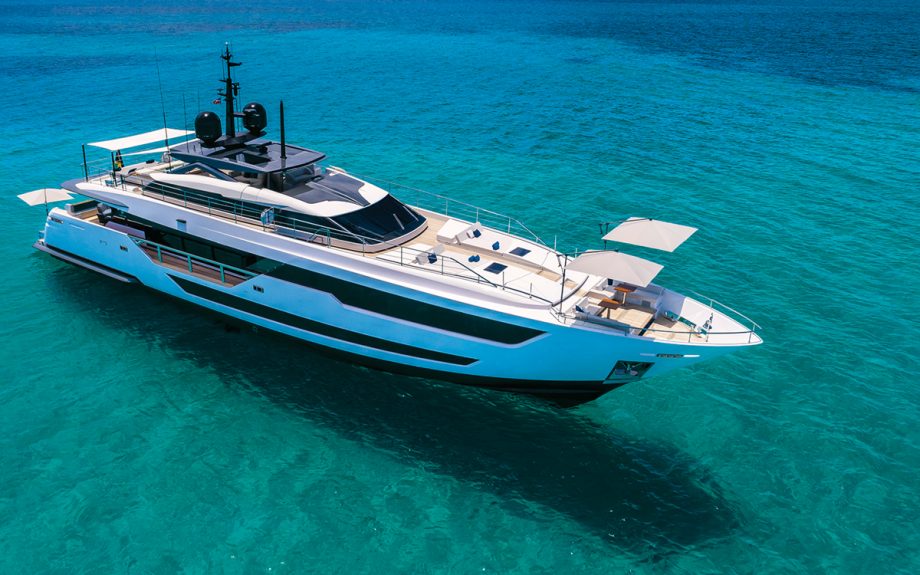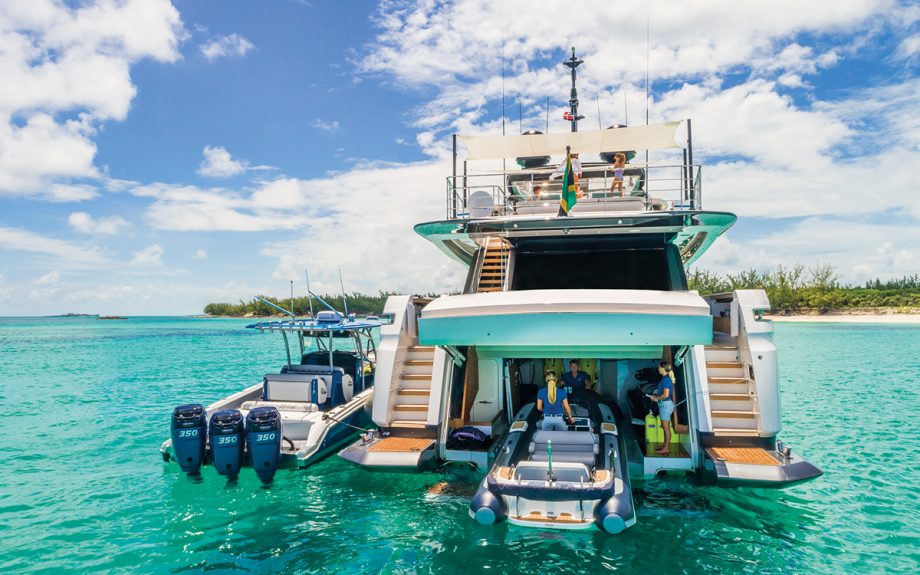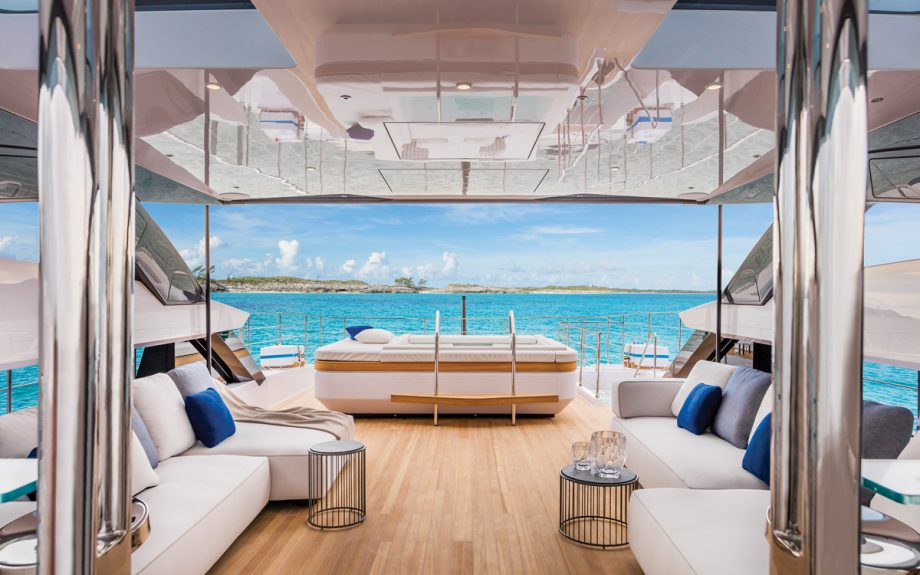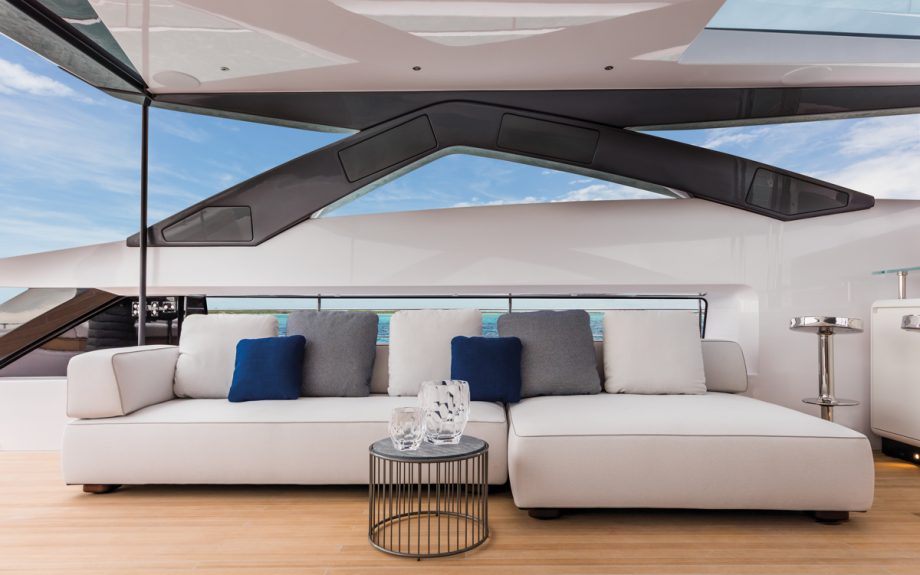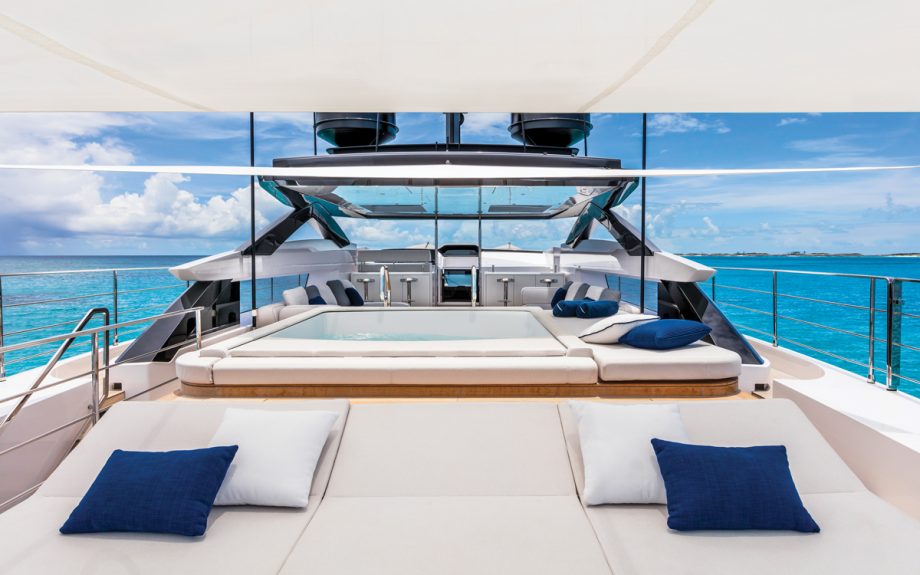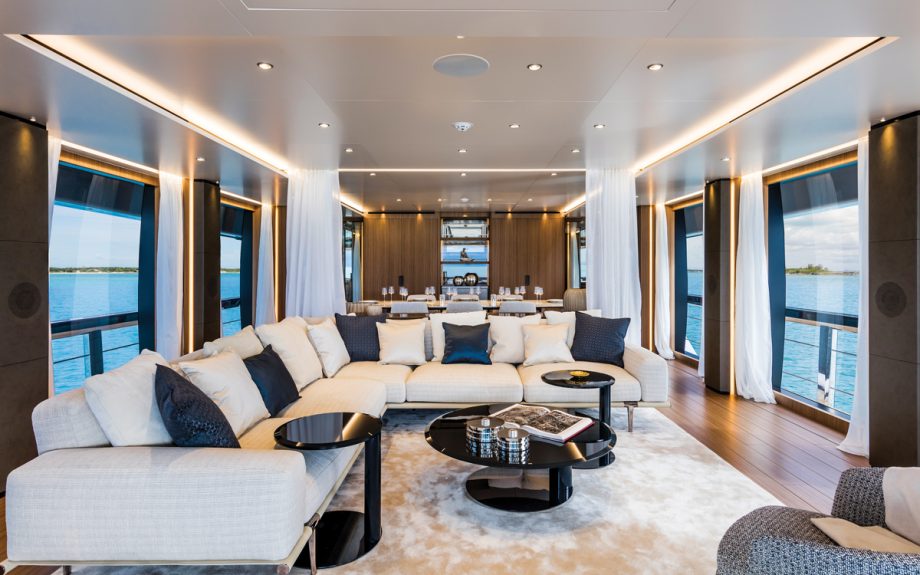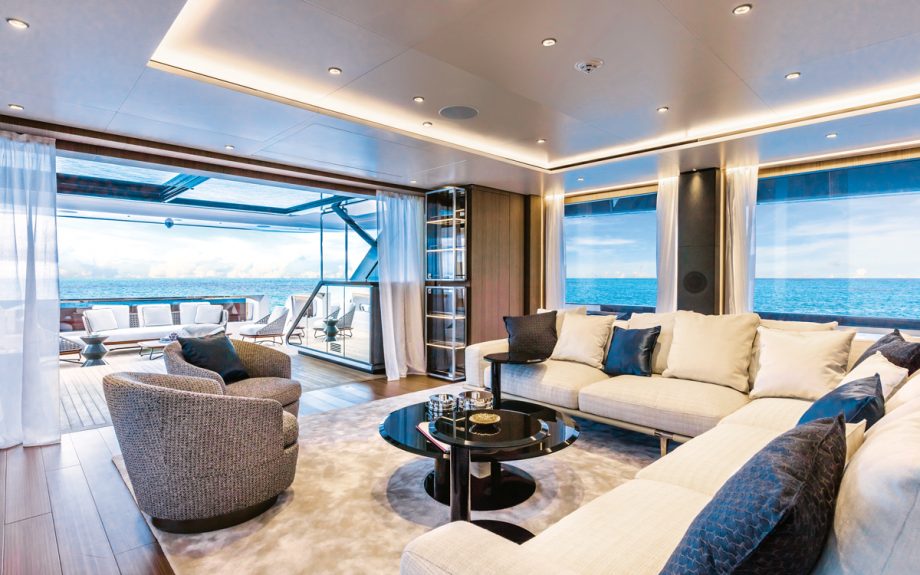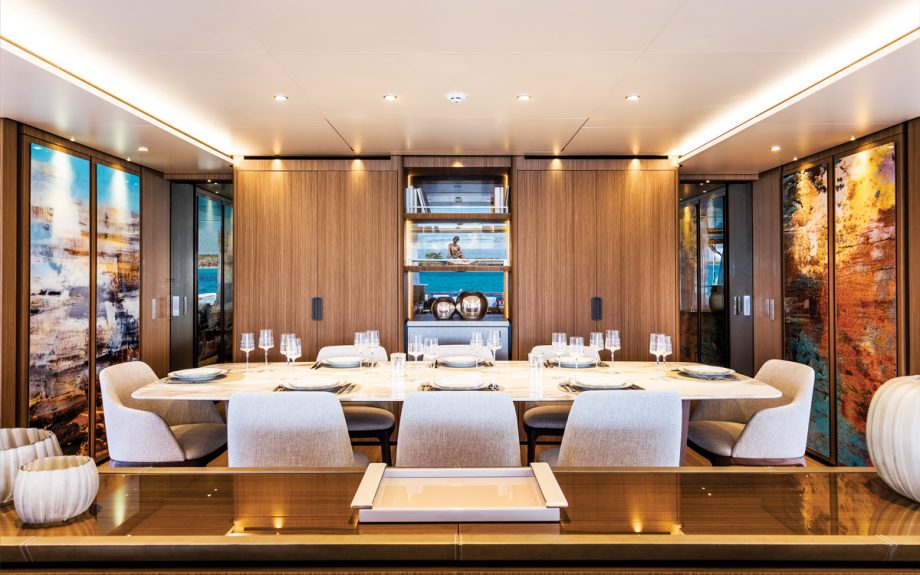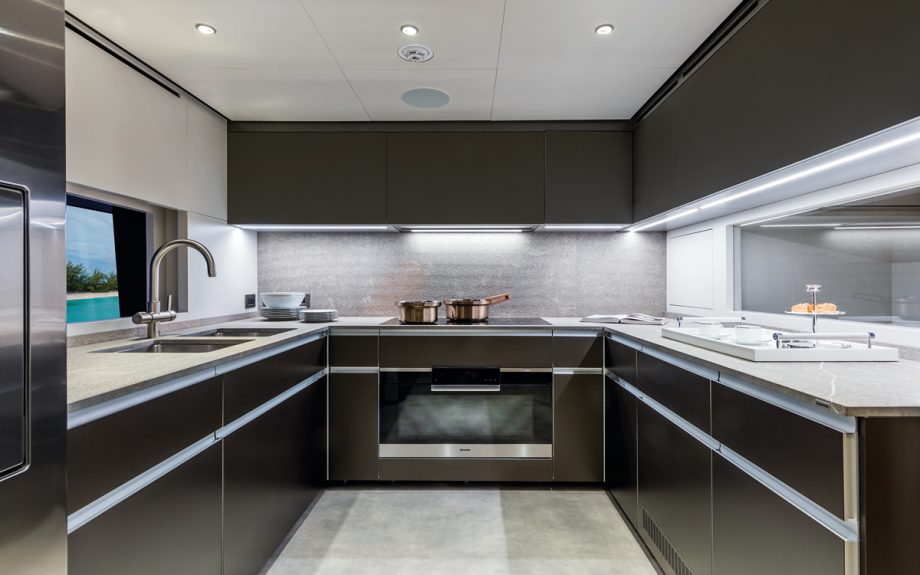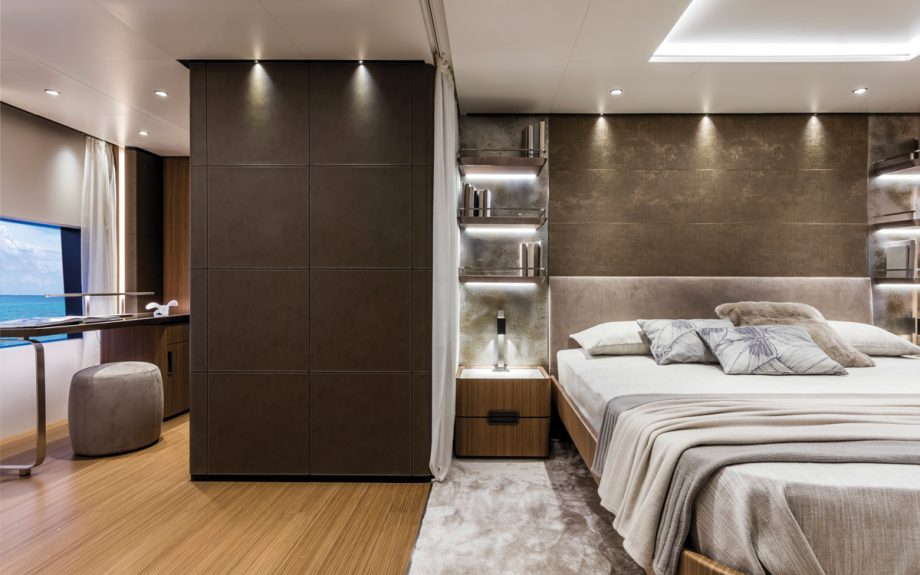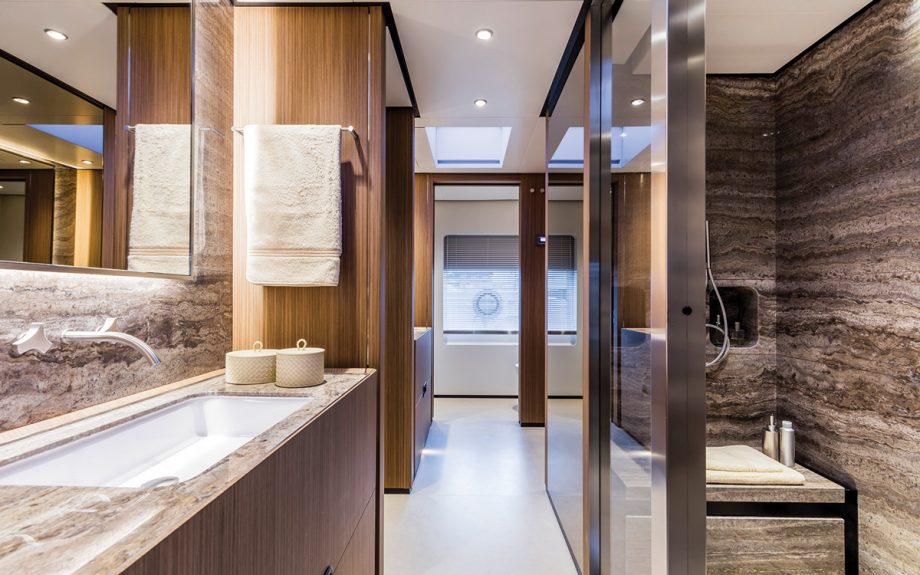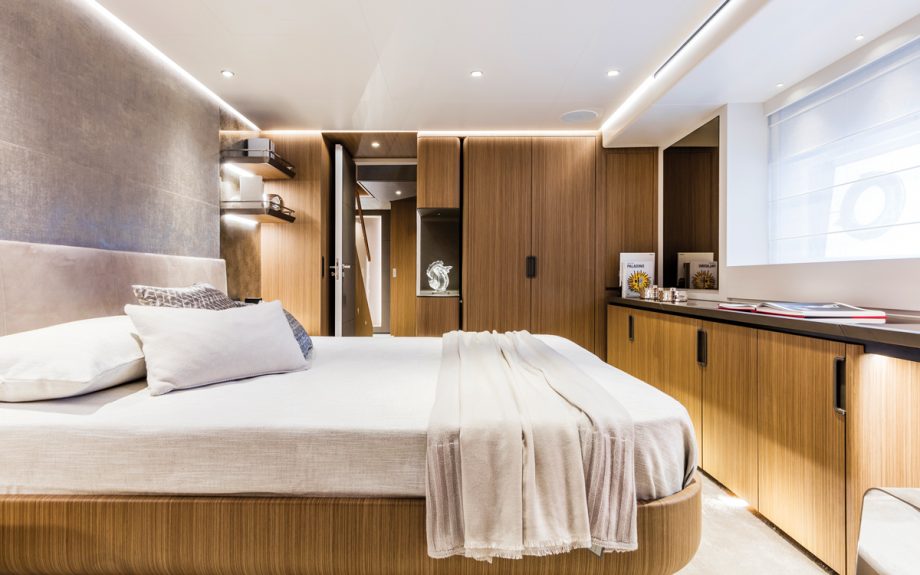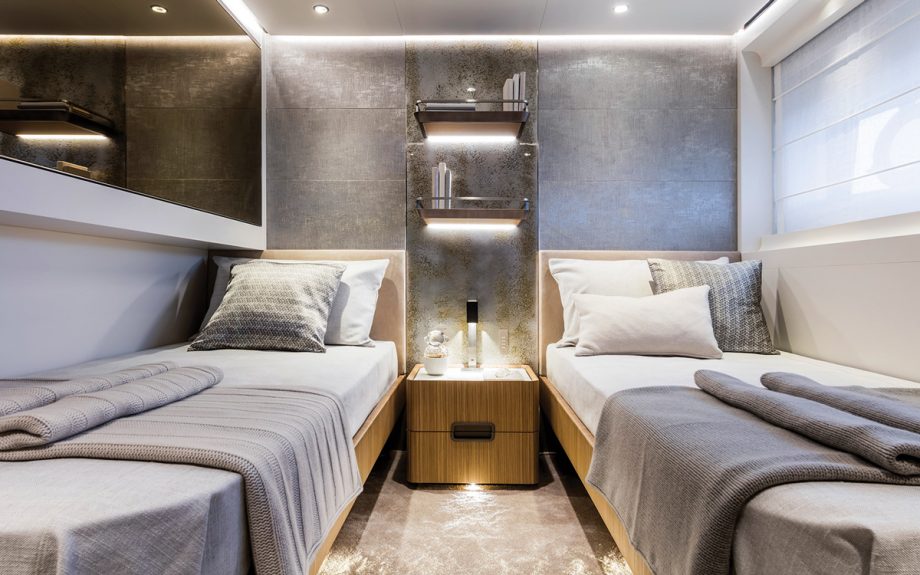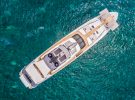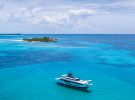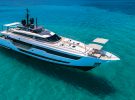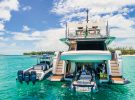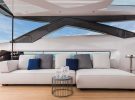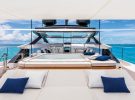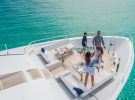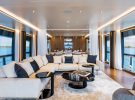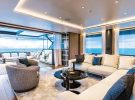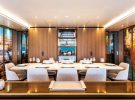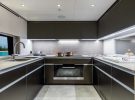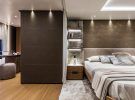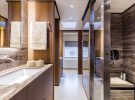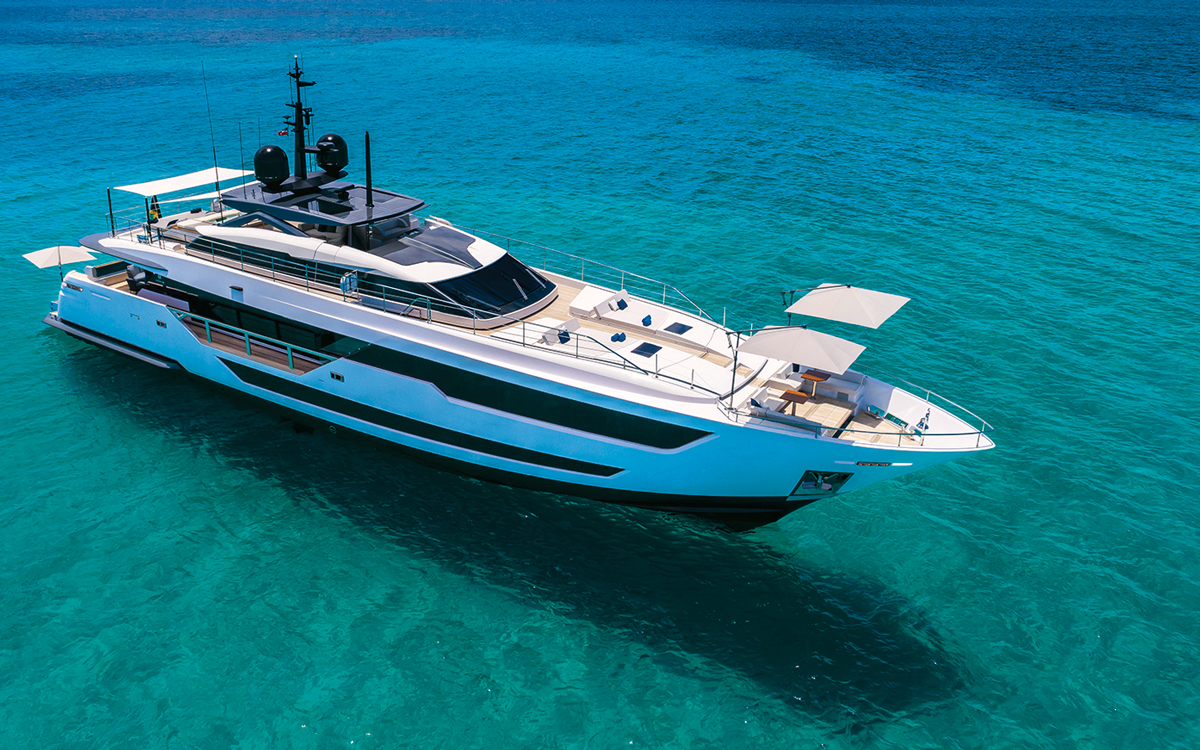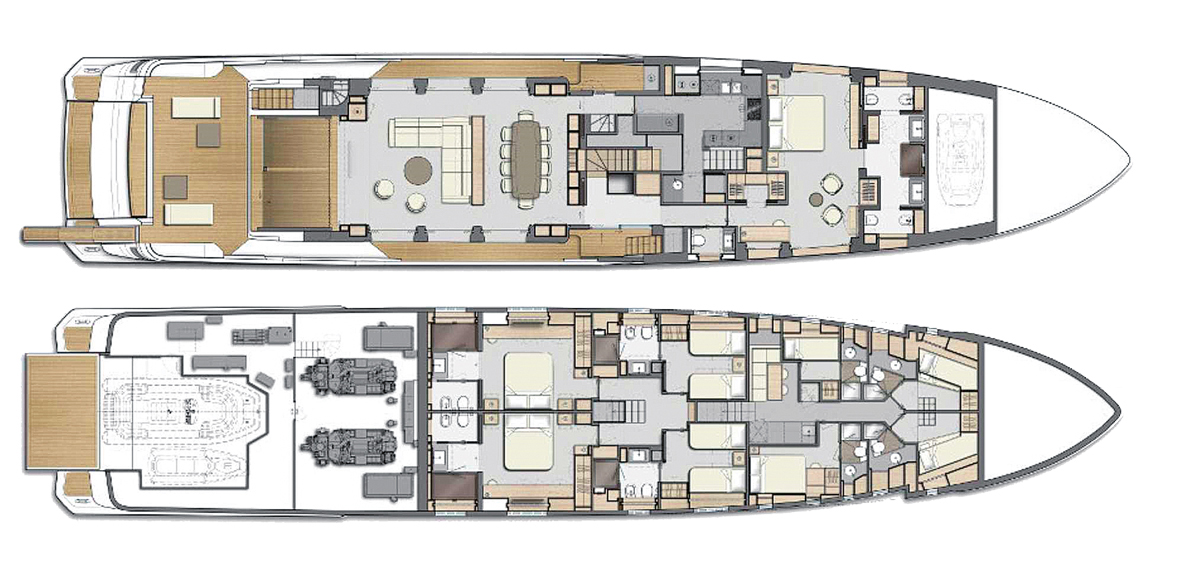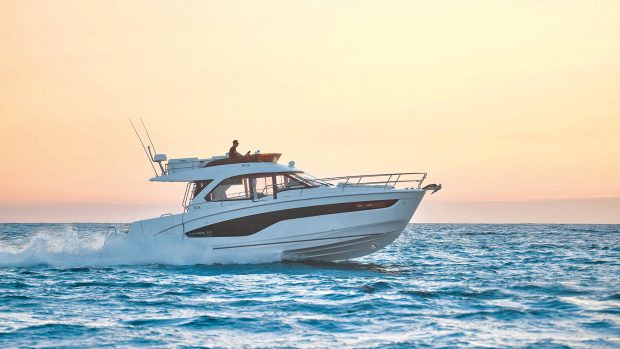The Custom Line 120 takes opulence to a whole new level, as we discovered on a sea trial in the gin-clear waters of the Mediterranean
Custom Line’s dramatic new 120 isn’t quite the biggest yacht that the shipyard has ever built but it’s not far off. That accolade belongs to the Custom Line 128, a 2003 model that stretched the tape to a shade under 130ft (39.6m). It has been out of production for some years.
In fact the Custom Line model that had most influence on the development of the Ancona shipyard’s latest flagship is the 124 – not because it showed the way forward, but because it didn’t. The Custom Line 124, a sleek, 27-knot greyhound of a vessel with a markedly military aspect to its profile, as if all it needed before joining the navy of some Middle Eastern potentate was a coat of dazzle camouflage, provided a perfect proof of the law of diminishing returns.
So you could read the Custom Line 120 as an anti-124. With its extravagantly glazed superyacht styling no-one is going to mistake it for a patrol boat, whatever colour it’s painted. More importantly the new Custom Line 120 is slightly bigger than the 124, slightly lighter, almost as fast, but less powerful. And that is the key to the concept. The Custom Line 120 is a lot more efficient.
Where the 124 packed a pair of 4000-series MTU engines, providing 6,920hp between them, the Custom Line 120 makes do with two of the latest 2000-series, with a combined output of 5,270hp. And yet the 25.1 knots it reached during our sea trial off Cannes was achieved without fuss, and with a realistic cruising load of seven tonnes of fuel and water, not to mention 20-odd people on board.
The Custom Line 120 displaces about ten per cent less than the 124, thanks in no small part to the huge difference in the weight of the engines and their ancillaries, which amounts to more than 10 tonnes. But apart from that there are no particularly obvious signs that the designers have been desperately trying to pare the yacht’s weight down to a minimum.
Sure, there is plenty of carbon fibre reinforcement in the superstructure, but that can’t possibly offset the undoubted weight of the elegantly curved, floor-to-ceiling glazing in the deck saloon. Every other guest space on board also gets its share of glass. The Custom Line 120 feels solid, and heavy, like a luxury yacht should.
Article continues below…
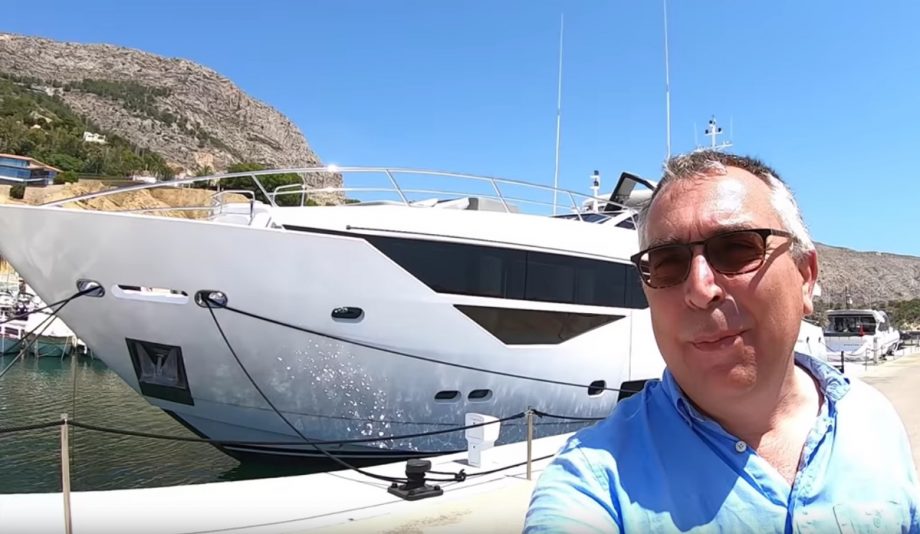
Sunseeker 116 yacht tour: Inside a raised pilothouse superyacht

Azimut Grande 27M: Game-changing ideas abound on luxurious cruiser
And then there are the cockpit doors, which have themselves won at least one innovation award. Built around a heavy steel frame and set at 45° across the aft end of the saloon, they can either slide open in the conventional way – although walking through a doorway that leans at such an extreme angle hardly feels conventional – or the entire structure, hinged along its top edge, can be raised and secreted into the deckhead, opening up the main deck in the most dramatic fashion imaginable.
It’s like someone has knocked down a wall, and is a triumphant tour de force. The cost of these clever doors? A mere 1.7 tonnes. You just don’t do things like that if you’re worried about weight.
The point is that although the Custom Line 120 is lighter than its predecessor, it could easily have been lighter still. But the designers were able to build in all the luxury they needed to, which always carries a weight penalty, because they knew they held a trump card – a new, efficient hull design.
The only clue that there might be something unusual going on beneath the waterline is in the Custom Line 120’s elegantly curved stem, which meets the water at an almost vertical angle.
This is a semi-displacement hull, designed to cut through the waves rather than ride over them, which features remarkably fine and elongated forward sections that might remind you of pre-war designs, when naval architects didn’t have the horsepower available today and had to build speed into the shapes of their hulls by minimising resistance.
Designed by Massimo Verme and thoroughly tank tested, the Custom Line 120’s hull works beautifully. Conditions during our test were hardly a challenge, but it was nevertheless easy to sense how the reduced buoyancy in those slender forward sections prevented the bow from trying to rise to every provocation, instead providing a smooth ride as it sliced cleanly through them.
Under way at its optimum cruising speed of around 22 knots, the Custom Line 120 exudes a calm authority, and feels like a significantly longer vessel.
Verme was not the only new name that Custom Line engaged. The eminent Florentine designer Francesco Paszkowski styled the exterior and not only conceived those extraordinary cockpit doors, but also built in another intriguing innovation. In a cleverly asymmetrical deck layout, there is a continuous walkway from the upper deck to the foredeck seating on the port side, and a conventional side deck and companionway to starboard.
It’s extremely practical, and makes it much easier for both guests and crew to get around the boat – and because asymmetrical yachts are quite correctly regarded with suspicion by all right-thinking people, unless you’re looking very closely it’s totally inconspicuous from a distance.
Paszkowski’s business partner Margherita Casprini designed the yacht’s remarkably low-key interior. “I tried to keep it calm,” she explained. “The brief was a for a natural feel, getting the inside and outside to work together.”
The sheer quantity of glass employed in the superstructure and topsides must have limited her options, but she didn’t see it that way: “The layout of the saloon is all about enjoying the view,” she said. “The colours and surfaces also emphasise nature: there are matt floors, leathers, natural wood finishes and rounded edges.”
A beautiful master suite is set forward on the main deck, spanning the full beam of the hull, with enormous side windows to maximise the sense of light and space. Down below, another benefit of the Custom Line 120’s clever engine selection reveals itself.
The 124’s huge 4000-series MTUs and their ancillaries – the gearboxes alone are nearly four tonnes apiece – require not only a substantial machinery space but bigger fuel tanks as well, all of which eats into the hull volume available for the tender garage, crew accommodation and, of course, guest suites.
The Custom Line 120’s comparatively compact 2000-series V16s, on the other hand, help to ensure that the guests won’t feel too hard done by if they’ve managed to catch a glimpse of the master.
Headroom throughout the lower deck is a substantial 6ft 9in (2.06m), and our test yacht was fitted out with a pair of large double ensuites amidships, insulated from the engineroom by their roomy bathrooms, and two twin-berth ensuites forward of the central lobby, all with excellent hull windows.
The crew cabins in the bow – four ensuites, for a maximum of seven people – are accessed through the port side galley on the main deck, while at the other end the tender garage can take a 5.5m Williams with a PWC alongside it. The engineroom itself, meanwhile, is delightful: spacious and bright with a separate services area and room to get all around the flat-mounted motors.
Price as reviewed:
£11,000,000.00 ex. VAT
Verdict
Even for a company as experienced as Custom Line, the new 120 comes across as a remarkably accomplished yacht. The injection of new ideas and new designers has worked beautifully in both the interior and the external spaces, and it is a pleasure to be aboard. The hull design speaks for itself out at sea, and underpins the Custom Line 120 as a very serious piece of work. It might not be quite the biggest yacht that Custom Line has built – but it must be in contention for the best.
Details
LOA: 125ft 10in (38.36m)
LWL: 103ft 0in (31.40m)
Beam: 25ft 1in (7.65m)
Draught: 7ft 0in (2.13m)
Fuel capacity: 16,000 litres (3,520 gal)
Water capacity: 3,000 litres (660 gal)
Displacement (light): 149,000 kg (328,000 lb)
Test engines: Twin 2,638hp MTU 16V M96L
Top speed on test: 25.1 knots
Fast cruising speed: 18.4 knots
Fuel consumption at 18.4 knots: 618lph
Cruising range at 10 knots: 1,471 nautical miles



